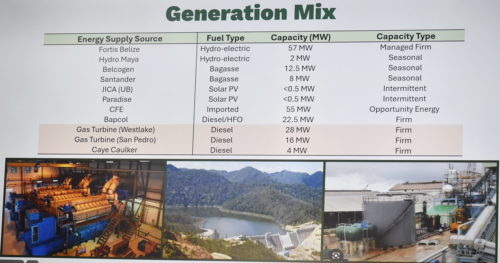Photo: BEL’s Chief Executive Officer, John Mencias
by William Ysaguirre
BELIZE CITY, Thurs. Dec. 5, 2024
Belize Electricity Limited (BEL) has increased its in-country capacity to generate power by 33 percent this year, through upgrades to the Westlake gas turbine (completed in May) that increased power supply by 25 megawatts, and the deployment of a mobile gas turbine that was brought online in San Pedro in mid-November. BEL will also apply to the government and the Public Utilities Commission for emergency generation procurement, as part of its plans to increase domestic power generation over the next five years to have a safety factor of 28 percent excess generating capacity in-country. Those plans were shared with the public by BEL’s chief executive officer, John Mencias, at a press briefing at the BEL headquarters last Friday, November 29.

Photo: BEL’s Energy Supply & Systems Control Manager, Omereyon Fregene
The investments have become necessary to avert the disastrous scenario the company dealt with in May this year during the dry season, when domestic energy production from the hydroelectric facilities at Chalillo and Mollejon and from biomass generation at BELCOGEN could not meet the peak demand of 129 megawatts, and BEL was forced to buy power from Mexico’s Comision Federal de Electricidad (CFE) at exorbitant rates. In May, BEL’s average cost of power was 54 cents per kilowatt-hour, while the average rate Belizean consumers were paying was only 40 cents/kilowatt-hour, and as a result the company lost $17 million. CFE’s price for power in May was 65 cents/kwh, and BEL continued to hemorrhage money in June, when CFE’s rate fell to 53 cts/kwh, reducing BEL’s average cost of power to 47cts/kwh. This was still far more than Belizean consumers were paying, with economic rates at 32 cts/kwh and commercial/industrial rates at 43cts/kwh. However, the company reported a profit of $6.8 million for the month of October, when its average cost of power fell to 20 cts/kwh, and the company hopes to recoup some of its loss, so that annual losses will be less than $10 million by the end of the fiscal year, Mencias projected.
Meanwhile, the company will move ahead with plans to replace 16,000 street lamps around the country with LED lights, which will reduce demand by about one megawatt. This would be enough to power 1,000 households. The company also encourages consumers to make their homes as energy efficient as possible by replacing older incandescent bulbs with low-cost LED lights or fluorescent bulbs, and to adopt energy saving practices such as turning off the lights and any other appliances when not in use.

BEL anticipates that peak demand will grow by about 6 percent per year to 137 megawatts in May 2025, while current in-country supply is only about 127 – 131 megawatts. This is a variable, as some of BEL’s in-country power supply is intermittent and others are seasonal, BEL energy supply and systems control manager Omereyon Fregene explained. BEL has about 123.5 megawatts of firm supply, of which 57MW is supplied by means of the Chalillo, Mollejon and Vaca dams managed by FORTIS, with another 28MW from the Westlake gas turbine, 16 MW from the San Pedro gas turbine, and 22.5MW from BAPCol (Blair Athol Power Company Ltd.). Additional energy from other sources, such as 12.5MW from BELCOGEN and 8MW from Santander, have the advantage of being clean “green”, renewable energy, but are only seasonal during the sugar cane harvest. BEL can obtain some solar power from the JICA solar array managed by the University of Belize, and from Paradise Shrimp Farm, but these are less than one megawatt combined and intermittent at best, depending on the amount of sunshine that is accessed. BEL makes up the difference by importing power from CFE, up to 55 megawatts. Despite all this, the company projects that peak demand will exceed in-country generating capacity in May and June 2025, by as much as 5 Megawatts in late June.
Modulating these fluctuations to guarantee consumers reliable power at a constant, secure price is the reason the company has embarked on a 20-year expansion and modernization plan, explained systems planning and engineering manager Sheena Kuylen-Simpson. The parameters are to achieve supply at the least cost and risk, thereby improving reliability and supply from in-country sources, which would make the system more resilient against the interruption of supply from any one producer.
The aim is for Belize to have 75 percent of its energy coming from renewable sources by 2030. The company has applied to the government for permission to buy storage batteries over the next two years, to store enough energy to supply 40 megawatts for 8 hours. These would be located in San Pedro, Orange Walk, Ladyville and Dangriga. Another 20 megawatts of battery storage capacity would be bought to supply 8 hours of power for the Belize District. This Battery Energy Storage System (BESS) would eliminate the situation where the company lurches from one crisis to another, with unplanned power outages when CFE cannot supply us with power, because it will enable the company to buy and store the power when the prices are as low as 20cts/kwh in off-peak hours, in order to have adequate power to supply on hand when needed at peak demand.
This will minimize the need to increase rates to the consumer within this planning period and beyond, Kuylen-Simpson explained.
The primary aim is energy security, and having a reliable power supply at the best price, from whatever source, CEO Mencias concluded.
(AMANDALA Ed. Note: A good explanation by “Union of Concerned Scientists” at www.ucsusa.org says that “Megawatts are used to measure the output of a power plant or the amount of electricity required by an entire city. One megawatt (MW) = 1,000 kilowatts = 1,000,000 watts…”)

